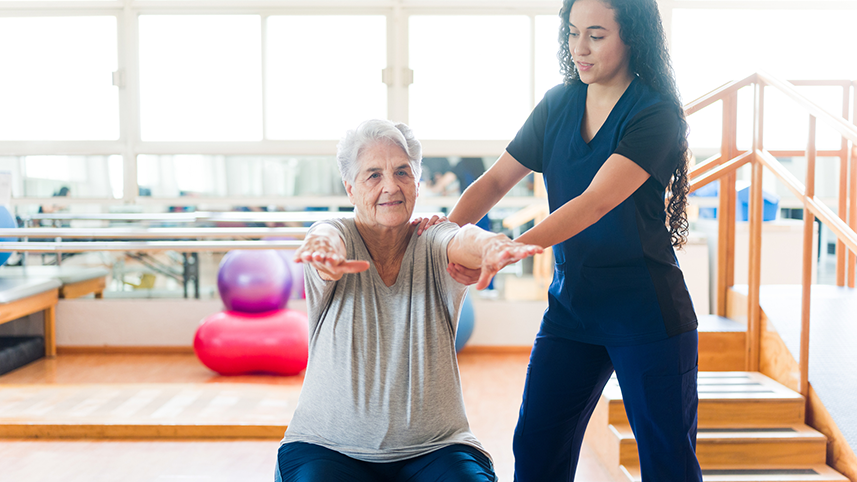The Balancing Act: How to Improve Stability & Step with Confidence
September 22, 2025
Categories: Staying Active
According to the CDC, more than 14 million adults aged 65 and older experience falls each year in the United States.
Our programs at Trinity Health PACE (Program of All-Inclusive Care for the Elderly) work closely with participants in building balance and reducing falls. Our rehabilitative therapists understand different barriers some might face including:
- Lower muscle strength
- Chronic conditions like diabetes, high blood pressure
- Joint pain
- Inner ear fluid/changes
- Lack of awareness
- Doubt of ability
- Access to resources/equipment

We spoke with an occupational therapist at one of our Pennsylvania programs, Mercy LIFE, to learn more about how our participants can improve balance and stay safe.
April DeSantis, OT, shared that working on balance not only helps reduce falls but makes simple, daily tasks like standing, sitting, and walking more feasible. Read on to learn more.
Q: What are some key techniques rehab therapists use to support balance development?
Some main things we focus on are exercises with weight training, weight shifting on extremities (for example, controlled movement of your body’s weight from one leg to another), and holistic approaches like Tai Chi or yoga.
Another thing to think about when you are talking about balance is proprioception. Proprioception is the sensory info that you get from your muscles, tendons and ligaments that tells your brain where your body is in space. If someone has great proprioception, they can sense their body’s position, movement, and the work their joints/muscles are doing without having to look. This is helped by the vestibular system, inner ear and eyes.
Q: Are there any specific exercises you instruct participants to practice regularly?
Yes, we have a wide range of activities and exercises that help build function and mobility including:
- Sit to stands
- Single leg stance
- Step-ups
- Standing with eyes closed
- Lunges
- Using a Bosu ball
- Cone pick ups
- Toe raises
- Heel-toe walking
- Backwards walking
- Side stepping over objects
Q: Is there any technology participants can use to help with balance?
There is so much technology out there in the rehab world for building balance. One new item we have been using is a vibration board/plate. This is a big hit amongst our participants and colleagues. Studies have shown the use of the boards reduces falls within the elderly population.
The boards work by forcing muscles to constantly contract and relax, and as a result, it helps build muscle, bone density, improves circulation, and enhances sensory processing – which in turn helps improve balance.
We, as therapists at Trinity Health PACE, strive to keep our participants safe and healthy in every aspect of their lives. We aim to keep them as independent as possible at home and in the community.
Ready to Learn More?
Programs of All-Inclusive Care for the Elderly (PACE) coordinate full-circle care for each participant. In addition to occupational, physical, and recreation therapists, each center across Trinity Health PACE has a team of providers including a nurse, primary care physician, social worker, and registered dietitian. All colleagues work closely with the participant and their family members to meet their individual needs and goals.
View Our Services